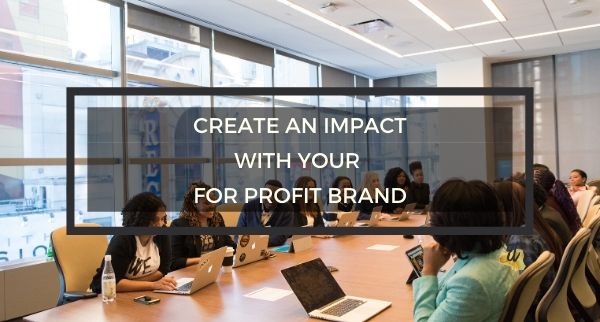I talk about creating an impact with your for-profit brand all the time, however, what I’ve noticed is, when I talk about creating an impact with for-profit brands, it becomes complicated. Company members don’t see how it’s possible without getting complicated about it. I’m here to tell you, it’s super simple and the first place we need to start is… getting rid of the complicated.
Conscious business, in my opinion, is the new wave of business. 2020 is marking a new decade full of new challenges and new buyers. The business landscape has really changed. We even have different types of business leaders at the helm. Today, we’re seeing more and more Conscious Leaders representing CEOs of major brands. Without getting into all the nitty-gritty – I’ll save that for another article, it’s clear to many that times are a changin, and with that, the business world must change too.
Conscious business is being introduced at a more rapid pace because the buyers of this decade demand it. You’ve heard me say it over and over, like a broken record. Gen Xers, Millennials, and Gen Zs are looking for brands that are responsible. Brands that give back in a meaningful way. Brands that create an impact through tangible action vs charitable donations. These buyers demand action. And, that’s all based on how they’re experiencing society, the environment, and the economy. With all 3 in desperate need of real and meaningful help, it’s no wonder these demographics are looking to big businesses to make the change.
So, how does a for-profit brand introduce such a concept in a non-complicated way? I’ve got just the solution for you, let me break it down.
First, you need to understand what your brand’s values and mission are. In other words, what are you about? What do you represent? From there, you need to understand your risk. What type of footprint, or lack of footprint are you leaving behind as a company?
Are you a major carbon-emitting company?
Do you represent diversity within your organization?
Are you 1 of the top revenue-earning businesses that’s giving back to your community?
Are your manufacturers producing toxic waste and ignoring ethical removal practices?
Are you a communications and media company using your broadcast power to combat and bring awareness to social issues such as inequality or climate action?
These are just a few brainstormed ideas but you get the gist? Where are you in relation to your sector, what’s your footprint or lack of footprint, and what type of legacy do you want to leave behind?
Typically, when working with me, once you as an organization have decided what your values and mission are, I not only run a sector-based risk assessment for you but I also have us look into the United Nations 17 Sustainable Development Goals (UN SDGs) to help narrow down a focus for impact. Using these targets ensures we’re not only creating impact, but we’re doing it in a meaningful way.
Here are the UN’s 17 SDGs:
- No Poverty
- Zero Hunger
- Good Health & Well Being
- Quality Education
- Gender Equality
- Clean Water & Sanitization
- Affordable & Clean Energy
- Decent Work & Economic Growth
- Industry, Innovation & Infrastructure
- Reduced Inequalities
- Sustainable Cities & Communities
- Responsible Consumption & Production
- Climate Action
- Life Below Water
- Life on Land
- Peace, Justice & Strong Institutions
- Partnership for the Goals
Now, I typically say start small. Pick the top 3 SDGs based on your values, mission, risk assessment, and the legacy you’d like to leave behind as a company then, create some ideas. Based on what you’ve chosen, what impact can your company create?
Here’s a super simple and effective example of how a CEO and company put together a couple of goals to create an impact in a meaningful way.
In late May 2020, the notorious Gary Vaynerchuk of Vaynermedia put on a 12 hour Tik Tok #allinchallenge. This broadcast was created to raise money to help feed and support kids, seniors, those who’ve lost their jobs, and front line workers all negatively affected by the even more notorious Coronavirus. Gary V used his power and privilege and asked his over 4 million followers to join him and Tik Tok as they partnered together to put on an epic show while raising money. Gary had different celebrity guests appear, and Tik Tok matched dollar for dollar for a full 12 hours. Over the span of that broadcast, these 2 companies and guests raised a whopping $2.3 million dollars that benefited Meals on Wheels.
In this example, whether the companies were aware of it or not, they combined 2 powerful SDGs in their strategy to create impact. Gary V and Tik Tok used UN SDG 2: Zero Hunger, and UN SDG 17: Partnership for the Goals to raise $2.3 million dollars in 12 hours to help feed those affected by the pandemic.
Do you see how simple your strategy can really be? And do you see how creative you can get when you start combining goals? What kind of company are you? What type of influence do you have? How can you most effectively give back in the most meaningful way? How can you continue to build awareness on your target?
Here’s the craziest part of all this. Although these Conscious Businesses were trying to do a good thing, there was a byproduct advantage to this whole strategy for these for-profit business. Point blank, more followers, more business, bigger ROI for the 2 companies.
So, going back to the top, for-profit companies can easily transition into Conscious Business, effectively delivering meaningful impact in a non-complicated way that not only benefits social and environmental issues but also captures the attention of today’s consumers.
Take this article back to your team and start brainstorming some easy, effective solutions your company can start working on today to create meaningful impact. And, as always, if you need help, click here or below to schedule a Preliminary Consult with me to get the ball rolling.

